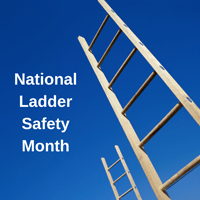March Is National Ladder Safety Month
Written by Staff Writer

Ladders are surprisingly dangerous. Falling from a ladder leads to dozens of deaths and thousands of injuries each year. Falls are the leading cause of death in the construction industry and one of OSHA's Focus Four workplace hazards.
March is National Ladder Safety Month. Each year, employers and workers alike can take this opportunity to reduce ladder-related accidents and fall hazards in the workplace.
Even if you don't work on or around ladders on a regular basis, the lessons below can protect you whenever you need to use these helpful reach-extenders.
Here are some helpful tips to always keep in mind when using a ladder provided by OSHA:
- Read and follow all labels/markings on the ladder.
- Avoid electrical hazards! – Look for overhead power lines before handling a ladder. Avoid using a metal ladder near power lines or exposed energized electrical equipment.
- Always inspect the ladder prior to using it. If the ladder is damaged, it must be removed from service and tagged until repaired or discarded.
- Always maintain a 3-point (two hands and a foot, or two feet and a hand) contact on the ladder when climbing. Keep your body near the middle of the step and always face the ladder while climbing.
- Only use ladders and appropriate accessories (ladder levelers, jacks or hooks) for their designed purposes.
- Ladders must be free of any slippery material on the rungs, steps or feet.
- Do not use a self-supporting ladder (e.g., step ladder) as a single ladder or in a partially closed position.
- Do not use the top step/rung of a ladder as a step/rung unless it was designed for that purpose.
- Use a ladder only on a stable and level surface, unless it has been secured (top or bottom) to prevent displacement.
- Do not place a ladder on boxes, barrels or other unstable bases to obtain additional height.
- Do not move or shift a ladder while a person or equipment is on the ladder.
- An extension or straight ladder used to access an elevated surface must extend at least 3 feet above the point of support. Do not stand on the three top rungs of a straight, single or extension ladder.
- The proper angle for setting up a ladder is to place its base a quarter of the working length of the ladder from the wall or other vertical surface.
- A ladder placed in any location where it can be displaced by other work activities must be secured to prevent displacement, or a barricade must be erected to keep traffic away from the ladder.
- Be sure that all locks on an extension ladder are properly engaged.
- Do not exceed the maximum load rating of a ladder. Be aware of the ladder's load rating and of the weight it is supporting, including the weight of any tools or equipment.
While some of these do's and don'ts may seem obvious, it's important to keep things in perspective.
Ladder-related injuries and fatalities are completely preventable. Proper training and careful attention are key to ladder safety.
Learn How to Prevent Ladder-Related Accidents
OSHA Education Center offers high-quality online training courses for ladder safety. Our educational compliance programs are available 24/7 from any internet-connected computer, laptop, tablet or mobile device. In just one hour, you can learn how to protect yourself from a dangerous fall while using a ladder.
Pick the course that is right for you. We offer training for workers in both construction and general industry roles. Once you sign up, you can start and stop your lessons whenever it is convenient for you. Train at your pace and make your jobsite a safer place for everyone.
